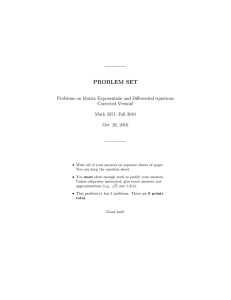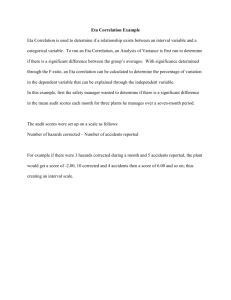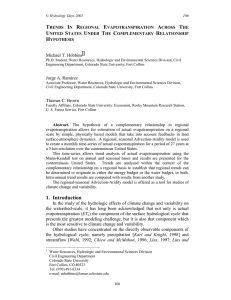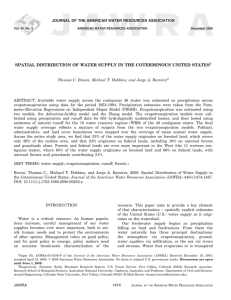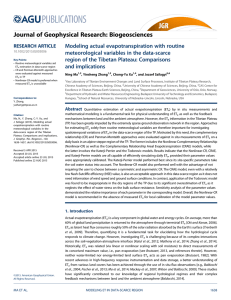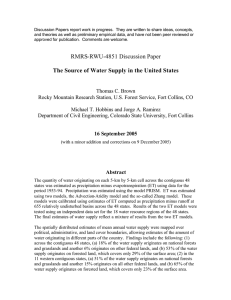2008 final exam 1a 1b A
advertisement
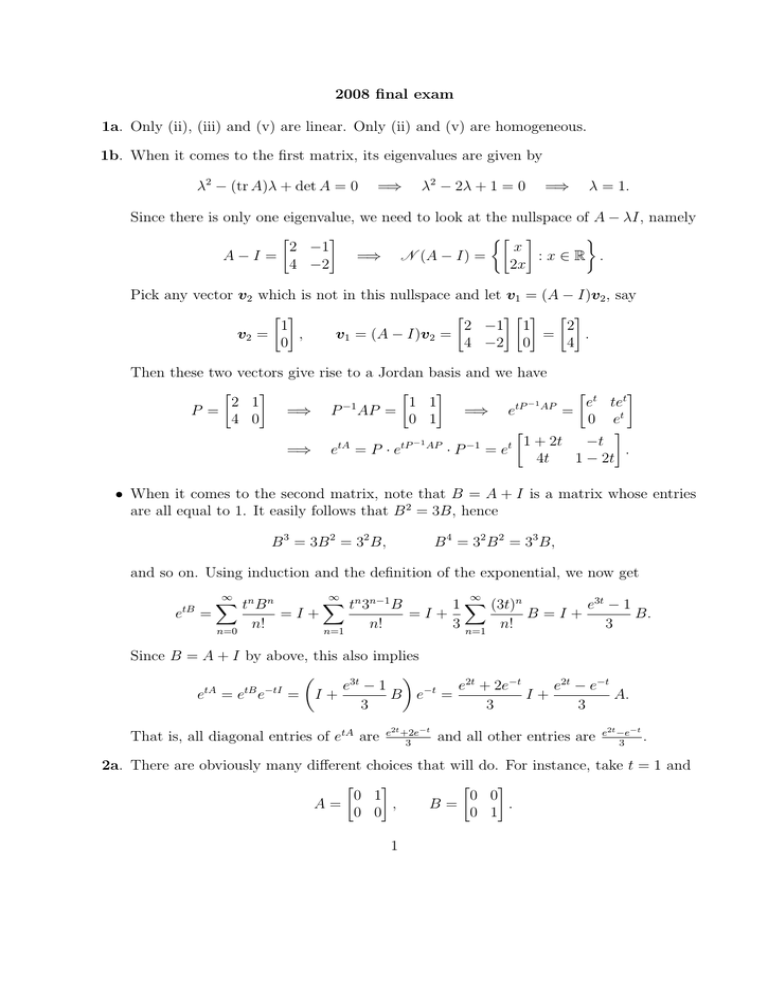
2008 final exam
1a. Only (ii), (iii) and (v) are linear. Only (ii) and (v) are homogeneous.
1b. When it comes to the first matrix, its eigenvalues are given by
λ2 − (tr A)λ + det A = 0
=⇒
λ2 − 2λ + 1 = 0
=⇒
λ = 1.
Since there is only one eigenvalue, we need to look at the nullspace of A − λI, namely
[
]
{[ ]
}
2 −1
x
A−I =
=⇒ N (A − I) =
:x∈R .
4 −2
2x
Pick any vector v2 which is not in this nullspace and let v1 = (A − I)v2 , say
[ ]
[
][ ] [ ]
1
2 −1 1
2
v2 =
,
v1 = (A − I)v2 =
=
.
0
4 −2 0
4
Then these two vectors give rise to a Jordan
[
]
[
2 1
1
−1
P =
=⇒ P AP =
4 0
0
=⇒
etA
basis and we have
]
[ t
]
1
e tet
tP −1 AP
=⇒ e
=
1
0 et
]
[
−t
tP −1 AP
−1
t 1 + 2t
.
=P ·e
·P =e
4t
1 − 2t
• When it comes to the second matrix, note that B = A + I is a matrix whose entries
are all equal to 1. It easily follows that B 2 = 3B, hence
B 3 = 3B 2 = 32 B,
B 4 = 32 B 2 = 33 B,
and so on. Using induction and the definition of the exponential, we now get
etB =
∞ n n
∑
t B
n=0
n!
=I+
∞ n n−1
∑
t 3 B
n=1
n!
1 ∑ (3t)n
e3t − 1
B=I+
B.
3 n=1 n!
3
∞
=I+
Since B = A + I by above, this also implies
)
(
e2t + 2e−t
e2t − e−t
e3t − 1
−t
tA
tB −tI
B e =
I+
A.
e =e e = I+
3
3
3
That is, all diagonal entries of etA are
e2t +2e−t
3
and all other entries are
e2t −e−t
.
3
2a. There are obviously many different choices that will do. For instance, take t = 1 and
[
]
[
]
0 1
0 0
A=
,
B=
.
0 0
0 1
1
Then A is a Jordan block and B is diagonal,
[
][
1 1 1
A B
e e =
0 1 0
[
][
1 0 1
B A
e e =
0 e 0
so one can easily compute
] [
]
0
1 e
=
,
e
0 e
] [
]
1
1 1
=
.
1
0 e
To compute the exponential of A + B, we now use the fact that
[
[
]
]
0 1
0 1
n
A+B =
=⇒ (A + B) =
=A+B
0 1
0 1
for each n ≥ 1. In view of the definition of the exponential, this gives
eA+B =
∞
∞
∑
∑
1
1
(A + B)n = I +
(A + B)
n!
n!
n=0
n=1
[
]
1 e−1
= I + (e − 1)(A + B) =
0
e
so the three matrices eA eB , eB eA and eA+B are all distinct.
2b. Differentiating the first equation twice, one finds that
(A + B)2 et(A+B) = A2 etA etB + 2AetA BetB + etA B 2 etB .
Setting t = 0 and simplifying, one thus arrives at
A2 + AB + BA + B 2 = A2 + 2AB + B 2
=⇒
BA = AB.
In fact, the same argument applies, if one starts with any of the given equations.
2c. To find the homogeneous solution xh , we note that
λ2 + 1 = 0
=⇒
λ = ±i
=⇒
xh = c1 sin t + c2 cos t.
Based on this fact, we now look for a particular solution of the form
xp = At2 + Bt + C
x′p = 2At + B
=⇒
=⇒
x′′p = 2A.
To say that xp is a solution of the given ODE is to say that
t2 = x′′p + xp = At2 + Bt + C + 2A.
This gives A = 1, B = 0 and also C = −2A = −2, hence
xp = t2 − 2
=⇒
x = c1 sin t + c2 cos t + t2 − 2.
Once we now note that x(0) = c2 − 2 and x′ (0) = c1 , it easily follows that
c2 − 2 = ξ,
c1 = η
x = η sin t + (ξ + 2) cos t + t2 − 2.
=⇒
2
3a. Both equations are first-order linear with integrating factor
(∫
)
2
µ = exp
2t dt = et .
When it comes to the first equation, one has
x′ + 2tx = 0
=⇒
(µx)′ = 0
=⇒
x = C/µ = Ce−t .
2
When it comes to the second equation, one similarly has
x′ + 2tx = t
=⇒
=⇒
(µx)′ = tet
1 2
µx = et + C
2
2
=⇒
x=
1
2
+ Ce−t .
2
3b. Using reduction of order, one can find a second solution x2 = x1 v by solving
( ′
)
2x1
4t3 + 2t
′′
v +
− 4
v ′ = 0.
x1
t + t2 + 4
Noting that
∫
2x′1
4t3 + 2t
− 4
dt = 2 log x1 − log(t4 + t2 + 4),
2
x1
t +t +4
we see that an integrating factor is given by
(∫
)
2x′1
4t3 + 2t
x21
t2 (t2 − 4)2
µ = exp
− 4
dt
=
=
.
x1
t + t2 + 4
t4 + t2 + 4
t4 + t2 + 4
We now multiply by this factor and we integrate to get
(µv ′ )′ = 0
=⇒
v′ =
C1 (t4 + t2 + 4)
C1
=
.
µ
t2 (t2 − 4)2
To integrate the function on the right, one needs to use partial fractions to write
t4 + t2 + 4
1/4
3/8
3/8
= 2 +
+
.
2
2
2
2
t (t − 4)
t
(t − 2)
(t + 2)2
Integrating the last equation and simplifying, we conclude that
(
)
1/4
3/8
3/8
C1 (t2 − 1)
v = −C1
+
+
+ C2 .
+ C2 = −
t
t−2 t+2
t(t2 − 4)
In particular, the desired solution x2 = x1 v of the given ODE is
x2 = x1 v = −C1 (t2 − 1) + C2 t(t2 − 4).
3
4a. I will not ask for any definitions.
4b. Indeed, E(t) = x′ (t)2 + x(t)4 is such that E ′ (t) = 2x′ (x′′ + 2x3 ) = 0.
4c. Since x′ (t)2 + x(t)4 = E(t) = E(0), both x′ (t) and x(t) are bounded at all times.
4d. Write the second-order equation x′′ + 2x3 = 0 as a first-order system, namely
x′ = y,
y ′ = x′′ = −2x3 .
According to part (b), this system has V (x, y) = x4 + y 2 as a Lyapunov function and
so the origin is stable by the Lyapunov theorem.
4e. It is not asymptotically stable because V (x, y) = x4 + y 2 is both positive definite and
conserved. That is, every solution which converges to the origin must satisfy
V (x0 , y0 ) = lim V (x(t), y(t)) = V (0, 0) = 0
=⇒
t→∞
(x0 , y0 ) = (0, 0)
and so solutions which start out near the origin cannot really converge to it.
5a. I will not ask for any definitions.
5b. This is a linear system whose eigenvalues are given by
λ2 − (tr A)λ + det A = 0
λ2 − 3aλ + 2a2 = 0
=⇒
=⇒
λ = a, 2a
so the origin is unstable when a > 0 and asymptotically stable when a < 0. To deal
with the remaining case a = 0, we note that
[
]
2b −b
A=
=⇒ A2 = 0 =⇒ etA = I + tA.
4b −2b
When a = 0 ̸= b, the entries of etA x0 are thus unbounded and the origin is unstable.
When a = b = 0, we have etA x0 = x0 so the origin is stable but not asymptotically.
5c. Note that V (x, y) = x2 + y 2 measures distance from the origin and that
V ∗ (x, y) = 2xx′ + 2yy ′ = 2ax2 (x2 + y 2 ) + 2ay 2 (x2 + y 2 ) = 2a(x2 + y 2 )2 .
If a < 0, this makes V a strict Lyapunov function and so the origin is asymptotically
stable. If a = 0, then distance from the origin is conserved, so the origin is stable but
not asymptotically. If a > 0, finally, then the computation above gives
∫
∫
dV
2
−2
= 2aV
=⇒
V dV = 2a dt =⇒ −V −1 = 2at − V0−1
dt
=⇒ V (t) = (1/V0 − 2at)−1 .
In particular, V (t) becomes arbitrarily large as t →
4
1
2aV0
so the origin is unstable.


